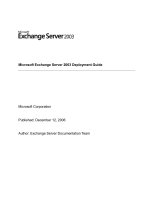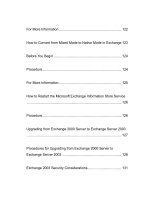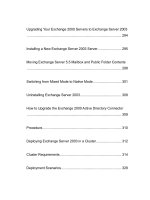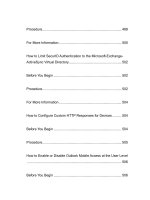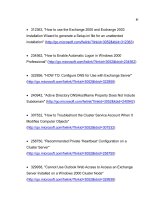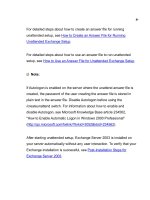Microsoft Exchange Server 2003 Deployment Guide- P16 ppsx
Bạn đang xem bản rút gọn của tài liệu. Xem và tải ngay bản đầy đủ của tài liệu tại đây (201.15 KB, 10 trang )
151
Outlook Web Access Content Expiration in Windows 2000 and Windows
Server 2003.
Log Buffers
If you previously tuned the msExchESEParamLogBuffers attribute
manually (for example, to 9000 [an Exchange 2000 SP2
recommendation], or 500 [an Exchange 2000 SP3 recommendation]),
clear the manual tuning. Exchange Server 2003 uses an optimal default
value of 500. For detailed steps about how to correctly configure the
msExchESEParamLogBuffers attribute for Exchange Server 2003, see
How to Set the msExchESEParamLogBuffers Attribute for Exchange.
Max Open Tables
If you tuned the msExchESEParamMaxOpenTables attribute manually,
you should clear the manual tuning. Exchange 2003 automatically
calculates an optimal default value based on the number of processors in
the server. For detailed steps on how to correctly configure the
msExchESEParamMaxOpenTables attribute for Exchange Server 2003,
see How to Set the msExchESEParamMaxOpenTables Attribute for
Exchange Server 2003.
152
Uninstalling Exchange Server 2003
After ensuring that your organization meets certain prerequisites, you can
run Exchange Setup to uninstall Exchange Server 2003. For detailed
steps, see How to Uninstall Exchange Server 2003.
How to Remove the Initial Memory Percentage Registry Value
The Initial Memory Percentage registry setting was introduced as
mechanism for fine tuning the initial amount of memory allocated to the
Exchange information store to 10 percent of the total physical memory in
the Exchange server. By starting out with this initial allocation and then
growing from there, virtual memory fragmentation does not occur as
frequently. This registry value should not be set arbitrarily, and should
only be used on the advice and direction of Microsoft Product Support
Services (PSS).
Exchange Server 2003 includes support for special startup switches in
Windows 2000 Advanced Server and Windows Server® 2003 that help
reduce virtual memory fragmentation, and additional changes were made
to help prevent virtual memory fragmentation in Exchange Server
clusters. Therefore, the Initial Memory Percentage registry value is no
longer needed on Exchange Server 2003.
153
The Initial Memory Percentage registry value works only on computers
that are running Exchange 2000 Server. Exchange Server 2003 will
ignore this value if present, and the value will have no effect. Therefore,
you should remove this registry entry before upgrading this Exchange
Server from Exchange 2000 Server to Exchange Server 2003.
Before You Begin
Before you perform the procedure in this topic, be aware that the
procedure contains information about editing the registry.
Caution:
Incorrectly editing the registry can cause serious problems that may
require you to reinstall your operating system. Problems resulting from
editing the registry incorrectly may not be able to be resolved. Before
editing the registry, back up any valuable data.
Procedure
To remove the Initial Memory Percentage registry setting
1. Start Registry Editor.
154
2. Navigate to
HKLM\System\CurrentControlSet\Services\MSExchangeIS\
ParametersSystem
3. In the right pane, delete the Initial Memory Percentage registry value.
4. Close Registry Editor and restart the Microsoft Exchange Information Store
service for the change to take effect.
For More Information
For information about a known issue when you use this registry value,
see Microsoft Knowledge Base article 810883, ""Initial Memory
Percentage" Registry Value Has No Effect"
(
For information about how to edit the registry, see Microsoft
Knowledge Base article 256986, "Description of the Microsoft Windows
Registry" (
How to Remove the MPHeap Parallelism Registry Value
In Exchange 2000, each time the Microsoft Exchange Information Store
service is started, the Exchange store process (Store.exe) gets its initial
155
process-heap. Then, a module loaded in the information store process—
ESE.DLL—allocates 4 JET heaps for each processor present in the
system.
Note:
Although these heaps are separate pools of memory in the information
store process, they are collectively referred to as the ESE multi-heap.
On a single CPU system, ESE allocates 4 JET heaps. On a dual CPU
system it allocates 8; on a quad system it allocates 16; and so forth.
When Exchange 2000 was installed on systems with four or more CPUs,
it was found that the ESE multi-heap caused excessive virtual memory
consumption, which in turn led to performance problems. To correct this
problem, it was recommended that customers with large Exchange 2000
servers add the MPHeaps parallelism registry value to their systems.
Exchange 2003 now automatically calculates the optimum number of
heaps to allocate based on the unique specifications of each system.
Therefore, the MPHeaps parallelism registry value should be removed
from Exchange 2000 servers after Exchange Server 2003 is installed.
156
Before You Begin
Before you perform the procedure in this topic, be aware that the
procedure contains information about editing the registry.
Caution:
Incorrectly editing the registry can cause serious problems that may
require you to reinstall your operating system. Problems resulting from
editing the registry incorrectly may not be able to be resolved. Before
editing the registry, back up any valuable data.
Procedure
To remove the MPHeap parallelism registry value
1. Start Registry Editor.
2. Navigate to HKLM\Software\Microsoft\ESE\Global\OS\Memory
3. In the right pane, delete the MPHeaps parallelism registry value.
4. Close the registry editor and restart the Microsoft Exchange
157
Information Store service for the change to take effect.
For More Information
For information about how to edit the registry, see Microsoft Knowledge
Base article 256986, "Description of the Microsoft Windows Registry,"
(
How to Configure Outlook Web Access Content Expiration in
Windows 2000 and Windows Server 2003
Microsoft Outlook Web Access 2003 is comprised partially of static files,
such as image files, scripts and so forth. To optimize performance, it is
recommended that the Exchweb virtual directory have its content
expiration set to 1 day.
Procedures
To configure Outlook Web Access content expiration in Windows
2000
1. Open Internet Information Services Manager.
158
2. Expand the server, and then expand Default Web Site.
3. Right-click the Exchweb virtual directory, and then click Properties.
4. Click the HTTP Headers tab.
5. Ensure that the Enable content expiration check box is selected.
6. Set the Web site content should field to Expire after 1 Day(s).
7. Click OK to save the change.
To configure Outlook Web Access content expiration in Windows
Server 2003
1. Open Internet Information Services Manager.
2. Expand the server, expand Web Sites, and then expand Default
Web Site.
3. Right-click the Exchweb virtual directory and click Properties.
159
4. Click the HTTP Headers tab.
5. Ensure that the Enable content expiration check box is selected.
6. Set the Web site content should field to Expire after 1 Day(s).
7. Click OK to save the change.
How to Set the msExchESEParamLogBuffers Attribute for Exchange
The msExchESEParamLogBuffers storage group attribute governs the
number of Extensible Storage Engine (ESE) log buffers that are used by
the Exchange information store. ESE uses a set of log buffers to hold
information in RAM before it writes to the transaction logs. Using these
buffers improves transaction logging performance. For large servers, the
default value of 84 is too low. This can cause excessive disk I/O
operations to the transaction log drive and, therefore, significant decrease
in performance if the server is under load or if users are sending large
messages. Increasing the number of ESE Log Buffers improves
performance, although it also causes more virtual memory usage.
160
To correctly set this value, use the following information:
For Exchange 2000 Server, Exchange 2000 Server Service Pack 1
(SP1), or Exchange 2000 Server Service Pack 2 (SP2), set this value to
9000.
For Exchange 2000 Server Service Pack 3 (SP3), set this value to
512.
For Exchange Server 2003, a default value of 500 is used, and you
should change the value for the msExchESEParamLogBuffers attribute
to 9000.
Note:
If you previously tuned log buffers to 9000, make sure that you
manually reduce this setting after you apply Exchange 2000 Server
SP3. This change is not made automatically when you install
Exchange 2000 Server SP3.
If you have log stalls, this may be caused by too low a buffer and you can
raise this value to 9000. The Database\Log Record Stalls/sec
performance counter can be monitored to determine whether log stalls
